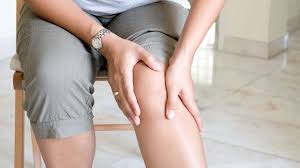Do you spend many hours in a sitting position at work in front of your desk? Do you have stiff knees afterward? Are your knees not only stiff but sore and with a restricted mobility at the same time? Stiffness after sitting should not be taken lightly and proper medical evaluation is needed.

What Causes Stiff Knees After Sitting?
You can experience stiff knees even after sitting with your knees crossed only for a couple of minutes. But sometimes, stiffness after sitting for a long period of time is a sign of a knee joint problem such as osteoarthritis.
In its early stages, knee stiffness tends to last only for a couple of minutes and normally you will be able to resume your daily activities without a problem. However, as your knee joints get even more damaged or if the joint stiffness occurs every day, you should seek medical help.
Common causes of stiff knees include:
Knee Osteoarthritis
Knee osteoarthritis is a condition which affects the knee joint, characterized by a damage of the cartilage covering the bones. As a result, the bones of the knees rub against each other while moving, leading to knee pain. As the condition progresses every day, stiff knees after sitting, painful knees while walking, and restricted knee movements are common signs of knee osteoarthritis.
Knee osteoarthritis is a condition with a very slow progression, as the cartilage of the knee joint gets damaged over many years. In general, knee osteoarthritis is diagnosed among elderly people.
Chondromalacia Patellae
Chondromalacia patellae is a condition characterized by a damage of the cartilage lying just underneath the kneecap. With every movement, the kneecap not in its proper position rubbers against the cartilage, leading to its damage, inflammation of the joint and stiff knees.
Some people have an increased risk of developing chondromalacia patellae, such as runners, soccer players, jumpers, etc. People who have had an accident and have damaged their kneecap are more likely to develop chondromalacia patellae.
How to Cope with Stiff Knees After Sitting
The treatment of stiff knees normally depends on the underlying cause. In order to diagnose the real cause of knee stiffness, certain tests and examinations are needed, including MRI scan, arthroscopy, etc.
Treat the Causes
Regardless whether knee osteoarthritis or chondromalacia patellae is causing you stiff knees, with proper medication these conditions and your symptoms can be managed effectively. Pain medications such as NSAIDs will help relieve the pain and discomfort. Another alternative treatment includes applying warm or cold packs to the affected knee.
- In cases of osteoarthritis, chondroitin sulfate supplements as well as glucosamine supplements will support cartilage growth and regeneration.
- If conservative treatment fails to relieve the symptoms and your knee stiffness becomes so severe that your movements are impaired, a total knee replacement or realigning the knee cap surgically may help resolve your problem.
In both conditions, staying away from certain activities like running or jogging is helpful as excessive stress on the knees will be eliminated. However, totally avoiding physical activity is not recommended as it will just make your problem get worse. Moderate physical activity and especially exercises in order to strengthen the muscles around your knee are very helpful.
Consult your healthcare provider before starting any exercise routine in order to determine if this physical activity and exercises are suitable for you.
Avoid Prolonged Postures
If you tend to have stiff knees after sitting for a prolonged period of time, start doing simple movements while you are resting and before standing up. Make sure to get up, move around the office and even do some stretching every 20 minutes. You can gently bend your knees backward, as well as, forwards.
This will help your knees stay lubricated and prevent your knees from getting stiff after sitting for a long period of time. This is very effective even though it sounds like a simple thing to do.
Lose Weight
If you are overweight or obese, you should make some effort and lose those extra pounds. If you gain 10 pounds, your knees will need to handle 30 pounds more pressure than before. Losing weight will significantly reduce the strain and pressure on your joints, relieving the signs and symptoms and slowing the progression of knee osteoarthritis.
